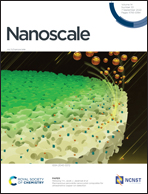Designing two-dimensional temperature profiles using tunable thermoplasmonics†
Abstract
Heat flow generation and manipulation in nanometer-sized solids using light represents one of the up-and-coming tasks in thermonanophotonics. Enhanced light–matter interaction due to plasmon resonance permits metallic nanostructures to absorb light energy efficiently, and it results in extra optical heating. The net temperature increment of nanostructures is directly dependent on heat exchange with a thermostat. However, to the best of our knowledge, precise tailoring of optical heating at a fixed pump power is still of no practical implementation. In this paper, we focus on the tunable optical heating of a plasmonic nanostructure exposed to moderate light intensity (MW cm−2) based on slowing down heat exchange through a 1D waveguide heatsink bridging the nanostructure and the highly thermal conducting thermostat. The rationale for this concept is evidenced through optical heating of a 2D array of stacked titanium nitride (TiN) (plasmonic refractory nanoheater) and height-controlled silicon (Si) (1D waveguide heatsink) cylinders. Depending on the Si pillar height, the temperature rise of a TiN : Si voxel ranges from a few up to thousands of degrees at a fixed pump power. The temperature of the TiN : Si voxel is remotely measured from the Raman shift of the Si pillar. Using ellipsometry, we find a temperature threshold of 400 °C, above which the thin TiN film is chemically degraded due to oxidation. The latter enables fine tailoring of thermal gradients using TiN : Si voxels of equal size but different permittivity. These findings contribute towards the development of tunable thermoplasmonics by demonstrating programmable non-uniform temperature profiles in the steady-state regime under continuous-wave laser illumination for a variety of thermo-optical applications.



 Please wait while we load your content...
Please wait while we load your content...